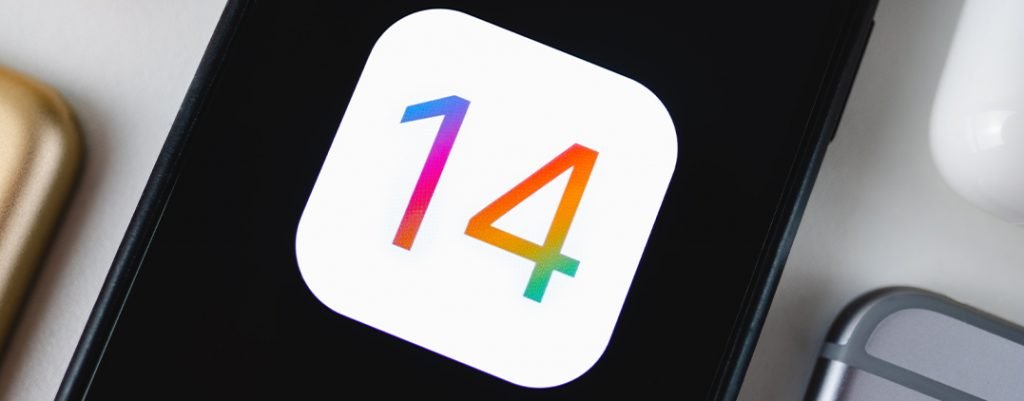Optimized for 8 Events Only
When creating a conversion campaign, it’s possible to optimize just one of the eight defined events. Before this rule started being enforced, it had still been possible to select an unspecified event and be given a yellow warning sign.
Now, it is possible to select only the events that have been set for optimization…
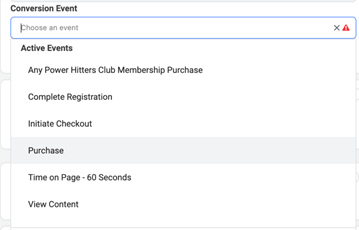
If you have not yet set up the events of your choice, you will need to do so by going to Events Manager> Aggregated Event Measurement> Manage Events. Just keep in mind you need to expect a delay of 72 hours before you can optimize any newly set up event.
If you are unable to set up your events, it is because you do not own the domain where events occur, or you need to verify domain ownership first.
Paused Ad Group
If you had created conversion-type campaigns before the iOS14 changes went into effect, and the optimization had been performed for an event not included in the eight pre-defined events, these ad groups will stop automatically.
It should look like this:
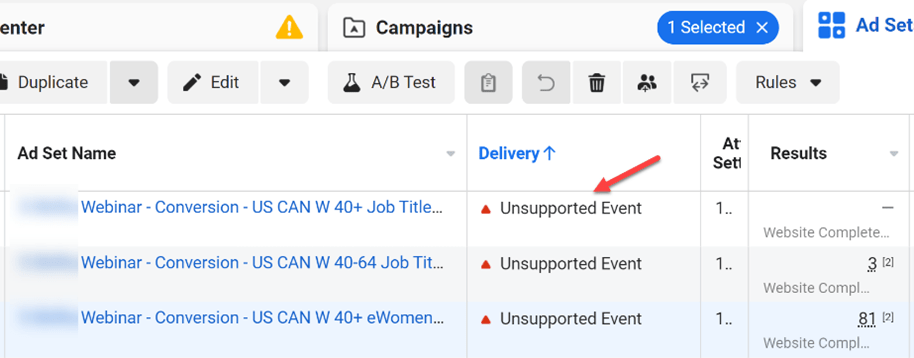
Late access to newly defined events
If you had created conversion-type campaigns before the iOS14 changes went into effect, and the optimization had been performed for an event not included in the eight pre-defined events, these ad groups will stop automatically.
It should look like this:
Audience segmentation
You’ve probably come across a Facebook message telling you your custom audiences are shrinking.

The above is especially relevant in case of audiences that include people who have removed themselves from iOS tracking. If you have built target audiences that include these people, expect such an audience to be incomplete.
That doesn’t mean you shouldn’t use the audiences you’ve build – just keep in mind they will be smaller. How much smaller? That depends on the volume and percentage of total traffic coming from iOS devices.
If you didn’t keep an eye on the size of such audiences closely, note that Facebook will not enable you to see the resulting difference in the audience size.
Suspended reporting
If a user chooses to remove themselves from iOS tracking, Facebook will show the highest event defined from a given visit. However, it will take up to three days for it to appear in your report.
In other words, you may want to ignore your conversion report in the last daily window. If you have significant iOS traffic, these numbers will not be complete.
Instead, consider customizing the report window for a three-day period.
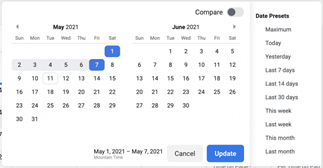
Consider how this affects automatic rules. If reporting for some of your conversions is delayed by up to three days, the last three-day window is not ideal for determining whether adjustments should be made. Unfortunately, Facebook does not provide a window that does not include the last three days.
Reporting unspecified events
Technically, you will still be allowed to add a column for unspecified events to your ad reporting using the Customize Columns feature.
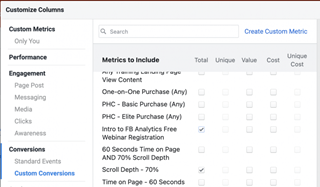
However, note that if these events occur with iOS users who have chosen to remove the tracking, these events will not be included in the report.
This is different from reporting events defined via cumulative event measurement. In such a case, Facebook will continue to display the highest-ranking event from a given visit. However, if you’ve never set an event (it is not rated), it will not appear in your report to iOS users who have canceled it.
In other words, expect undefined events to be less reported than defined events. If you have a significant iOS traffic, you may want to rely only on defined events for reporting.
Aggregated event measurement report
If you still can’t see the data that appear on the Aggregated Event Measurement tab in the Event Manager, you will see them soon.
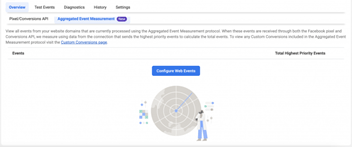
It turns out that Facebook will detail events that use the aggregated event measurement protocol. In other words, it will list the defined events that occurred, and display the number of times that each event was the highest priority event for a given visit by a user who selected iOS tracking.
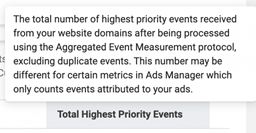
Note that it doesn’t matter if these events are attributed to ads. Contrary to your Ad Manager reports, this section will list all events – paid and organic – processed using this protocol.
In conclusion
Now that we experience the above changes in real time, there are a few things to keep in mind:
- Mobile traffic vs. desktop
Let’s say 50 percent of your audience owns an iOS device. This does not mean that 50 percent of your audiences and reports will be affected. Many owners of iOS devices also access your site from their desktop. In these cases, the tracking will take place as usual.
- How many will remove iOS tracking?
We’ve heard some initial reports on the number of people who have canceled the tracking, but they are still far from accurate. Plan the worst-case scenario but don’t assume anything yet. We will have to wait a while longer before we understand the full impact of the revoked consent. - Do not blame all the bad results on iOS14
During this period, it will be easy to blame any poorly performing campaign on iOS14. Were all campaigns effective before these changes? Probably not. It is important to separate iOS-related factors from those you can control (such as copy, creative, zip, product, etc.). - Be creative
You will have to start doing things differently than what you were used to. Give it a try. Investigate. Find solutions. This is not the time to be stubborn and stuck in your old ways.
Now that we experience the above changes in real time, there are a few things to keep in mind:
- Mobile traffic vs. desktop
Let’s say 50 percent of your audience owns an iOS device. This does not mean that 50 percent of your audiences and reports will be affected. Many owners of iOS devices also access your site from their desktop. In these cases, the tracking will take place as usual.
- How many will remove iOS tracking?
We’ve heard some initial reports on the number of people who have canceled the tracking, but they are still far from accurate. Plan the worst-case scenario but don’t assume anything yet. We will have to wait a while longer before we understand the full impact of the revoked consent. - Do not blame all the bad results on iOS14
During this period, it will be easy to blame any poorly performing campaign on iOS14. Were all campaigns effective before these changes? Probably not. It is important to separate iOS-related factors from those you can control (such as copy, creative, zip, product, etc.). - Be creative
You will have to start doing things differently than what you were used to. Give it a try. Investigate. Find solutions. This is not the time to be stubborn and stuck in your old ways.

